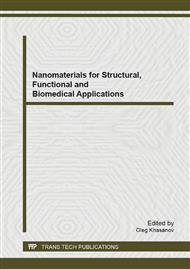[1]
B.J. Briscoe, S.K. Sinha, Wear of polymers. Proc. Inst. Mech. Eng. J. Eng. Tribol., 216 (2002), 401–413.
Google Scholar
[2]
Brian J. Briscoe and Sujeet K. Sinha, Tribological applications of polymers and their composites: Past, present and future prospects, in Tribology of polymeric nanocomposites by K. Friedrich and Alois K. Schlarb (ed. B.J. Briscoe), Elsevier, 2008, p.1.
DOI: 10.1016/b978-0-444-59455-6.00001-5
Google Scholar
[3]
Galetz M.C., Blar T., Ruckdaschel H ., Sandler K.W., Alstadt V. Carbon Nanofibre-Reinforced Ultrahigh Molecular Weiht Polyethylene for Tribological Applications, Journal of Applied Polymer Science. 104 (2007), 4173-4181.
DOI: 10.1002/app.26058
Google Scholar
[4]
Z. Wei, Ya-Pu Zhao, S.L. Ruan, P. Gao. A study of the tribological behavior of carbon-nanotube-reinforeed ultrahigh molecular weight polyethylene composites, Surface and interface analysis. 38 (2006), 883-886.
DOI: 10.1002/sia.2148
Google Scholar
[5]
Jiansong Zhou, Fengyuan Yan. Improvement of the Tribological Behavior of Ultra-High-Molecular-Weight Polyethylene by Incorporation of Poly (Phenyl p-Hydroxyzoate), Journal of Applied Polymer Science. 96 (2005), 2336-2343.
DOI: 10.1002/app.21534
Google Scholar
[6]
Jinggang Gai, Huilin Li . Ultrahigh Molecular Weight Polyethylene/Polypropylene/Organo-Montmorillonite Nanocomposites: Phase Morphology, Rheological and Mechanical Properties/ Jornal of Applied Polymer Science. 106(2007), 3023-3032.
DOI: 10.1002/app.26913
Google Scholar
[7]
Ruan S.L., Gao P., Yang X.G., Yu T.X. Toughening high performance ultrahigh molecular weight polyethylene using multiwalled carbon nanotubes, Polymer. 44 No. 19 (2003), 5643-5654.
DOI: 10.1016/s0032-3861(03)00628-1
Google Scholar
[8]
Eon Mi Lee, Young Se Oh, Hyun Soo Ha and Byung Kyu Kim. Rheological properties of UHMWPE/iPP blends, Polym. Adv. Technol. 20 (2009), 1121-1126.
DOI: 10.1002/pat.1387
Google Scholar
[9]
Myshkin N.K., Petrokovets M.I., Kovalev A.V. Tribology of polymers: Adhesion, friction, wear and massss-trasfer / Tribology International. 38 (2005), 910-921.
DOI: 10.1016/j.triboint.2005.07.016
Google Scholar
[10]
Navin Chang, A.M. Naik, H.K. Khaira. Developmtnt of UHMWPE Modified PP/PET Blends and Their Mechanical and Abrasive Wear Behavior. Polymer Composites. (2007), 267-272.
DOI: 10.1002/pc.20302
Google Scholar
[11]
Gongde Liu, Ming Xiang, Huilin Li. A Sudy on Sliding Wear of Ultrahigh Molecular Weight Polyethylene/polypropylene Blends, Polymer Engineering and Science. 44, No. 1, (2004), 197-208.
DOI: 10.1002/pen.20018
Google Scholar
[12]
S.V. Panin , L.A. Kornienko, V.P. Sergeev, N. Sonjaitham, M.V. Tchaikina. Wear-Resistant Ultrahigh-Molecular-Weight Polyethylene-Based Nano- and Microcomposites for Implants/Journal of Nanotechnology. 2012(2012), Article ID 729756, 7 p.
DOI: 10.1155/2012/729756
Google Scholar
[13]
S.A.R. Hashmi, Somit Neogi, Anuradha Pandey, Navin Chand. Sliding wear of PP/ UHMWPE blends: effect of blend composition, Wear. 247(2001), 9-14.
DOI: 10.1016/s0043-1648(00)00513-5
Google Scholar
[14]
N. Tretinnikov, Y. Ikada. Surface Characterization of ion-implanted Polyethylene, J. of Polymer Science: Part B. Polymer Physics. 36(1998), 715-725.
DOI: 10.1002/(sici)1099-0488(199803)36:4<715::aid-polb17>3.0.co;2-i
Google Scholar
[15]
S.V. Panin, L.А. Kornienko, S. Wannasri, L.R. Ivanova, S.V. Shilko. Comparison of effectiveness of the modification of UHMWPE by nanofibers (C, Al2O3) and nanoparticles (Cu, SiO2) for obtaining antifrictional composites, Journal of friction and wear. 31, No. 6 (2010).
DOI: 10.3103/s1068366610060097
Google Scholar
[16]
S.V. Panin, L.А. Kornienko, S. Piriyaon et al. Antifrictional nanocomposites based on chemically modified ultrahigh molecular weight polyethylene (UHMWPE). Part I. Mechanical and tribotechnical properties of chemically modified UHMWPE, Journal of friction and wear. 32, No. 3 (2011).
DOI: 10.3103/s1068366611030093
Google Scholar
[17]
S.V. Panin, L.А. Kornienko, S. Piriyaon et. al. Antifrictional nanocomposites based on chemically modified ultrahigh molecular weight polyethylene (UHMWPE). Part 2. Influence of nanofillers on mechanical and tribotechnical properties of chemically modified UHMWPE, Journal of friction and wear. 32, No. 4 (2011).
DOI: 10.3103/s106836661104009x
Google Scholar
[18]
G. Machado, E.L.G. Denardin, E.J. Kinast. Crystalline properties and morphological changes in plastically deformed isotaсtic polypropylene evaluated by X-ray diffraction and transmission electron microscopy, European Polymer Journal. 41 (2005).
DOI: 10.1016/j.eurpolymj.2004.08.011
Google Scholar


